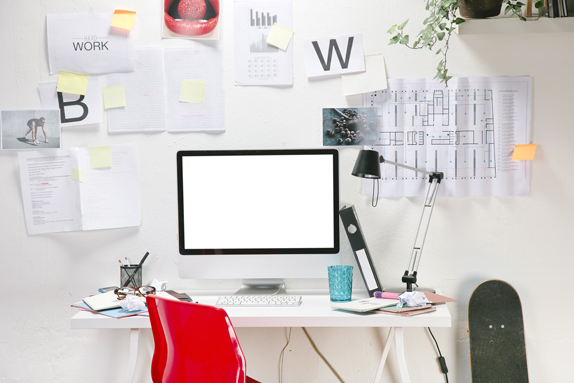Whether you work from home or not, most people have some type of home office or place where they do work from home either for their employer or for themselves. In this post, we are going to look at five things to consider when designing your home office to maximize productivity.
1. Proximity Matters
When you are designing a home office, make sure you put things that you need often near where you need them. For example, if you want to get better about shredding documents with sensitive information on them, don’t put your shredder across the room or in the closet. It needs to be out where you can easily get to it. The more effort it takes to do something, the less often you will want to do it, so arrange your tools so that it is easy to do your desired tasks.
Usually when my desk starts getting messy, I can trace it back to the fact that I have something placed incorrectly. For example, if my scanner isn’t easily within reach and hooked up, I won’t scan documents into my paperless system and they start stacking up on my desk. If my trash can were moved across the room, I’d end up with piles of stuff on my desk that should have been discarded.
2. Lighting Is Important
I had a friend who was studying interior design, and I was amazed at how much time they spent just studying how lighting worked. Her studies covered everything from the color of the lights to the spread of the light at different heights and everything in between. If you are like most people, your home office isn’t something you had a professional design, so pay attention to lighting. One thing I’ve found helpful is to use daylight color-balanced high-powered CFL bulbs. The daylight color helps keep you alert because it matches what you’d have outside. A lot of people don’t like the CFL bulbs because they often seem underpowered, but if you get an 85 watt CFL bulb, you’ll get a lot more light than you’ll get from a 100 or even 150 watt traditional light bulb.
3. Control Sound
Sound can be a big distraction in a home office, so think about whether or not you are trying to set up a workspace right next to a squeaky furnace fan or some other distraction. If you are in a room with a bare floor, you might find that putting down a rug helps absorb some of the sound and echoes. If you have a lot of traffic in a room above your head, you might consider insulating the ceiling to cut down on some of the noise.
If you have distracting sounds that you can’t block, you might consider playing some type of ambient sound to help cover up the distraction. This only works up to a point, but if you are trying to cover up a light conversation on the other side of the wall, ocean or rain sounds might do the trick.
4. Ergonomics
Typically you want your arms to bend at the elbows at 90 degrees, so adjust your desk or chair to keep from needing to reach up or down to type on your keyboard. Your wrists should be straight. Your monitor should be placed so you don’t have to tilt your head up or down to see it comfortably. OSHA has a lot of information on how to arrange an ergonomic workspace, but just paying a little attention to how your body feels and making adjustments can go a long way.
5. Invest in a Chair
Go ahead and invest in a good chair. “Invest” doesn’t necessarily mean “spend lots of money on,” but it does mean to put effort into finding something that is comfortable and works well for you. My office chair is over 10 years old, but I remember it took me about 6 months to find one that I actually liked after I started looking. It has been well worth it not because it was an expensive chair, but because I made sure it was exactly right for what I needed. If you don’t like your chair, you won’t want to sit in it, and it is hard to get work done if the piece of furniture you have the most contact with isn’t a good fit for you.

Your tips for a productive home office are excellent.
Another good tip is to make sure that your desk only has essential items on it, such as:
— your phone(s);
— a work lamp (if needed);
— a computer monitor(s) and keyboard;
— the project you are currently working on;
— and a few personal items to remind you why you are at work.